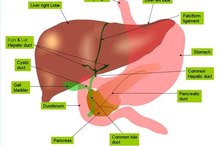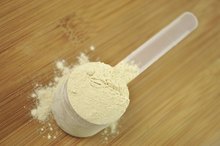Detoxifiers for High Ammonia Levels Due to Liver Diseases
A diseased liver cannot detoxify protein metabolites, such as ammonia, leading to increased levels in the blood. Liver damage prevents use of metabolites in your body because the liver is unable to filter, convert or utilize end-products. Ammonia, produced by bacterial activity on protein in the intestine, is absorbed and transported to the liver. The liver degrades ammonia into end products and waste products. Ammonia can circumvent a diseased liver and collect in the blood.
If you are experiencing serious medical symptoms, seek emergency treatment immediately.
Ammonia Toxicity
High blood ammonia levels can affect your brain, which is permeable to ammonia and highly sensitive to the toxic effects. Symptoms of toxicity might include confusion, lethargy, altered attention span and poor coordination. Increased ammonia levels in the brain can lead to swelling, edema, increased intracranial pressure and possible brain herniation. A clinical diagnosis, based on complaints, signs, symptoms and lab values, requires further research to exclude other significant causes of mental status changes.cause:
- A clinical diagnosis
- based on complaints
- signs
- symptoms
- lab values
- requires further research to exclude other significant causes of mental status changes
- High blood ammonia levels can affect your brain, which is permeable to ammonia and highly sensitive to the toxic effects.
- Increased ammonia levels in the brain can lead to swelling, edema, increased intracranial pressure and possible brain herniation.
Testing
Hepatic Encephalopathy Low-Protein Diet
Learn More
Plasma ammonia level is the test to determine ammonia content in your blood. But elevated levels might not reflect liver disease since increases also occur with congestive heart failure, gastrointestinal hemorrhage, certain medications and consuming protein before the test. Testing can indicate worsening liver disease, monitor treatment, and aid in the diagnosis of approaching hepatic coma. Remember that toxic levels can be higher in the brain than might be reflected in the blood.
- Plasma ammonia level is the test to determine ammonia content in your blood.
- But elevated levels might not reflect liver disease since increases also occur with congestive heart failure, gastrointestinal hemorrhage, certain medications and consuming protein before the test.
Laxatives
Laxative use is crucial to lowering ammonia levels in your gastrointestinal tract. The primary laxative used is lactulose, which alters your bacterial flora and makes fewer organisms available to produce ammonia. Lactulose dosages are regulated until 3 to 4 soft bowel movements occur daily. Another is magnesium citrate, frequently used to remove bloody stool after intestinal bleeding and administered via nasogastric tube to expedite blood removal.
- Laxative use is crucial to lowering ammonia levels in your gastrointestinal tract.
- Another is magnesium citrate, frequently used to remove bloody stool after intestinal bleeding and administered via nasogastric tube to expedite blood removal.
Antibiotics
How to Decrease Ammonia Levels
Learn More
Administering an antibiotic by the oral route, rather than intravenously, restricts the antibacterial action to only the gastrointestinal tract where it's needed. The primary goal is to reduce ammonia-producing bacteria from the intestine. Three of those antibiotics are neomycin, vancomycin and rifaximin 1. Occasionally, both an antibiotic and lactulose are given to reduce bacteria and improve clearance in the intestine. Administering at separate intervals prevents lactulose from removing the antibiotic too quickly.
- Administering an antibiotic by the oral route, rather than intravenously, restricts the antibacterial action to only the gastrointestinal tract where it's needed.
- Occasionally, both an antibiotic and lactulose are given to reduce bacteria and improve clearance in the intestine.
Additional Methods
Another method used to decrease ammonia production might include a temporary reduction in protein intake through diet. It can also include reducing or eliminating medications broken down by the liver, lowering the liver's workload. Avoiding medications that contain ammonium, such as antacids, are included in restrictions.
Related Articles
References
Writer Bio
Helen Messina started writing in 2010. She is a registered nurse with experience in rehabilitation, long-term/subacute care, pediatric/adult home care and has worked in acute care facilities in Florida, Pennsylvania, New Jersey and New York. Messina's specialties include neurology, cardiac and renal care. She holds an associate degree in nursing from Gannon University.









